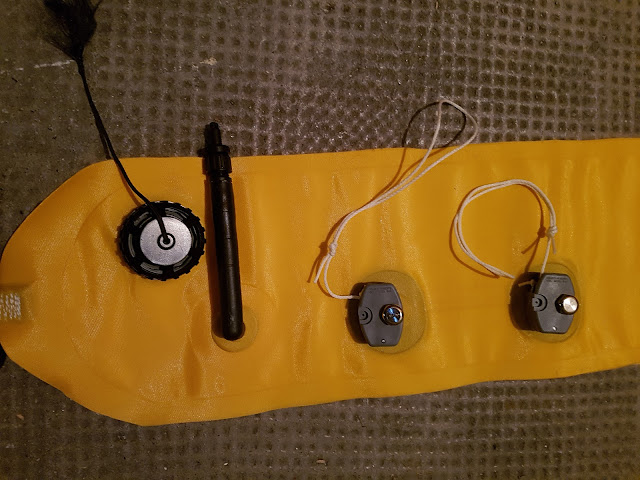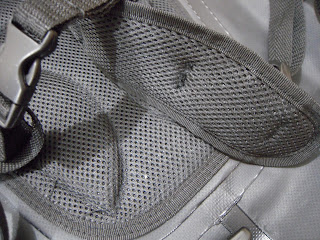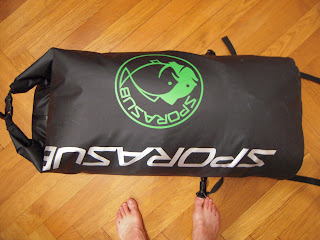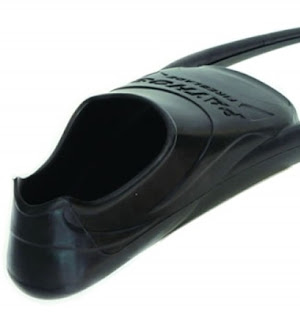Introduction
Fins are an important part of spearfishing gear, I would say that they are, with the Mask, (Snorkel/Tuba), and the
Spearfishing Apparatus, the most important gear. Any other gear you could live without and still spearfish (omitting laws & personal comfort). The fins are what will allow you to move in a fast, safe and fluid manner in the water; they also allow you to dive down in an easy way. Without fins a strong current could take you away, you could not move around under water easily to hunt and to dive down you would need a weight attached to a rope and a boat to allow you to go down fast and bring up the weight after each dive or a bottom anchor and a rope to climb down for each dive. Generally speaking your down time would be horrible and it would be very hard to spearfish like this.
Types of Fins
There are many types of fins:
- Snorkling
- SCUBA
- Freediving/Spearfishing
- Underwater hockey
- ...
The most common are the top three, in that order, I will not mention the forth type.
Scuba Fins
Scuba fins are
usually open heal to allow booties to be used:
They vary in length and width and may have other gadgets/shapes to them; They are however usually wider to overcome the resistance from all their equipment and rather short to be less cumbersome. The footpocket and the blade are permanently attached together in the fabrication process. The blade is made of some sort of plastic. Power transfer is not optimal with the open heal and they can be painful without booties or socks. This is not an issue for scuba divers as they don't really need to swim optimally, they are too heavy and not streamlined enough for that anyways and they have a large external oxygen reserve so usually they do not worry so much about using the O2 in their blood optimally (I am simplifying things here). These fins are not very good for spearfishing (just as a reminder I exclusively speak of apnea spearfishing in my blog).
Snorkeling Fins
Snorkeling fins are light & flexible closed heel fins:
They vary in length and width and may have other gadgets/shapes to them. They are usually less wide and longer than Scuba fins, they are also softer. The footpocket and the blade are permanently attached together in the fabrication process. The blade is made of some sort of plastic. This type of fin is usually meant to be used without socks but you can use socks if you want. You can use these fins for spearfishing, I have used them for several years (my most recent being the
Beuchat X-Voyager; this type of fin is cheap and if you get one with the right blade stiffness and long enough it is OK for shore/hole/reef/rock spearfishing. They may not be optimal but it will allow you to practice and perfect your technique.
Freediving/Spearfishing
These fins are long closed heel fins:
They vary in length but are much longer than the other fin types mentioned above:
The blade can be between 65cm and 85cm in length. The reason they are so long is that the blade's structure is linearly graded (thicker on one end and gradually getting thinner until the other end). This creates a leaver effect which give the fin a ratio between the energy the freediver has to give and the effective energy the fin generates is greater than any other fin type. This means that you use less O2. The footpocket is much stiffer than for other types of fins; this is to maximize power transfer (leg to blade). The footpocket and the blade can either be are permanently attached together in the fabrication process or separate. The separate type can be fixed permanently or modular; modular fins allow you in theory to buy a footpocket that fits you well/that you like and use blades from different brands, different materials, different stiffness, etc:
In practice not all blades fit with all brands, some footpockets have features that means only their blades will fit (Salvimar):
or make it difficult to fit other blades (Beuchat). Omer, SeacSub & Pathos seem to be the most generic. The blade can be made from different materials, I will talk about that later. They are usually meant to be used with socks but you can use them with socks if you want (if they fit and do not hurt your feet).
Freediving fins are however the most expensive types of fins, even the cheapest are more expensive than the expensive snorkeling fins. They are of course the best type for Spearfishing. I will exclusively talk about this type of fin from now on.
Parts
Fines are made up of two main parts, the footpocket:
and the blade:
The footpocket can either be open heel:
which are usually used with booties or socks The other type is closed heel:
Which are used it or without socks (but never booties).
The blade can be made of different materials (see below) and it can have some extra options (see below)
Footpockets
Footpockets can be made of one or several bonded materials; having different materials allows the footpocket to be reinforced in some places and softer in others with the aim of improving the mechanical aspects and comfort. For example the Cressi Gara Modular has a different material on the sides (harder) and in the middle (softer). You need to choose a footpocket that fits you well with socks, you can always use a fin keeper if they are a bit too big without the sock if you with to be able to not use socks at some point. The reason for using socks is more than just for thermal comfort, these types of footpockets are usually harder than snorkeling footpockets and they tend to have "sharp" edges which can cause a lot of pain. You could always trim or round them off a bit I guess if you really do not want socks, I have not tried. The footpockets have the part where your foot goes in, an opening in the front for the toes and to let water drain out, and "tendons", these are the long strips that extend on the front part. These have slots inside, usually in the shape of a 'T' for modular footpockets:
But not always:
The type without 'T' slots have to be glued with the blade. The blade slides in the tendon slots before sliding into the bottom slot of the footpocket:
The tendons come in different lengths and stiffness, this is important as it will directly impact the fin performance. For example a very stiff tendon and a soft fin means that only half the blade flexes correctly. I am not a specialist blade/tendon stiffness coupling so I will not be able to help much there, the best is to ask in specialized forums. Also, if the footpocket is too soft then energy is lost in the stretch, a bit like using a bicycle with suspensions in the city (you loose energy to the suspension). One last aspect, the most important, is the fit. It is hard to know in advance if it will fit correctly without actually trying it in water (with a blade in). First there are narrow footpockets such as:
and wide:
The pathos being particular in the fact that you can put on a smaller size (with or without socks) and heat them slowly with a hair drier and they will actually mold to your foot (including the distinctive left/right match). I have never tried this but you can find videos and instructions on the internet. If you cannot find your fit or you want dual use (with or without socks), you can get finkeeps to help:
An often overlooked aspect is the bottom, if you hunt around rocks this part can be useful so make sure it is sturdy enough and has some sort of ribbing to keep you from slipping:
Blade
The blade is the other main component of the fin, it can typically be made with (in order of ascending price):
- Thermoplastic
- Fiberglass
- Carbon fiber
- Kevlar
It has a narrower end (with or without an angle) that slides into the footpocket. The other end can have different shapes depending on the manufacturer/model:
Thermoplastic Blade
Thermoplastic blades are like tanks: heavy but indestructible; they are also the cheapest type. They have their place, I don't think you should just to carbon because you think it is better (because it isn't necessarily better). While they are heavier, thus adding fatigue to your legs, they are usually still good. They are robust which is important to some people, it depends how you hunt. Thermoplastic blades will outlast other types, they can be scratched, bent, etc, much more than other types. They do have a "usage/bending memory" though, this means that the more they are bent in one way they will retain that angle a little each time.
Fiberglass Blade
Fiberglass (sometimes called fiber composite) blades are lighter and more responsive (they snap back better) than thermoplastic blades. They are also more expensive and more fragile than plastic. They are, with carbon fiber blades (see below) real linear graded blades. Plastic blades often use ribs to give the same effect but composite blades rely on the material itself. They do not have the negative type of memory like plastic blades have but have less of a positive memory than carbon blades.
 |
| "Ice" Fiberglass blades |
 |
| Colored, can have patterns too |
Carbon fiber Blade
Carbon fiber blades are lighter and more responsive than fiberglass blades. They are also the most expensive and fragile of blade types. They tend to snap (brittle) in an instant if you over-power them and if you scratch them they can delaminate. These should be exclusively used for boat based (blue water) spearfishing since you have no contact with rocks/coral. This type of spearfishing also fits well with this blade because the blade's full potential can be used. Carbon fiber has an "initial/resting state memory" meaning they will always want to return to their initial (flat) state; this means that it helps the freediver a little each time.
Just remember not to jump in the water from the boat with your fins on because they will probably snap.
In general I would suggest:
- If you are a beginner, cash strapped, or hunt close to rocks/coral and do not want to be careful with your blades, get thermoplastic.
- If you do mixed spearfishing (rocks + some blue water) or are careful with your fins, and you are not cash strapped, you can get Fiberglass blades.
- If you solely do blue water spearfishing and money is no object, get carbon blades.
I do not recommend carbon blades if you do not practice blue water spearfishing. Some people swear by carbon no matter how you spearfish but I think this is wrong; each trade has its tools.
Kevlar Blade
Kevlar is a robust material with amazing tensile strength but it is a material which is quite hard to work with. Because of this, even though I have seen 100% Kevlar blades in the wild, it is mostly used in conjunction to other fibers, usually carbon. This makes it easier to work with and adds durability to carbon blades. It is typically either
- directly woven (crisscrossed) with carbon, this creates an average blade and is the least interesting combination. These are often called "Carbon/Kevlar Hybrid" blades.
- used as the core sandwiched in between carbon layers, this adds shear stress resistance to keep them from snapping. The carbon being on the outside layers the carbon fibers themselves do all the actual work. I will call these CKC blades.
- used to protect a carbon core by sandwiching it in between Kevlar. This is used in an attempt to still have a lightweight and reactive fins but also resist high abrasion or abuse around rocks. This variant is they type that Danny (see comments section) calls "Rock Hoppers". I will call these KCK blades.
Kevlar does degrade quickly if exposed to UV rays so it must be used with a UV resistant resins if you want it to last. It can make it tricky to buy because you have to be sure/trust that the maker used these types of resins. Even if the correct type of resin is used you have to be extra careful to keep it out of sunlight when not in use. CKC blades are probably a good alternative if you want to try to have the performance of carbon but because of your leg strength/way of using them they snap. KCK blades are a good alternative if you want the durability of fiberglass but want better performance. 100% Kevlar blades would be a better alternative than Fiberglass per se but it is almost impossible to find due to being so difficult to work with it and thus the price vs advantage ratio (compared to Fiberglass) is too low to be worth the effort.
Composite Blade Stiffness Comparison
I found a nice comparison of various composite materials used to make blades:
 |
| Source: Penetrator Fins |
You can read the whole post
here. Also of interest is
this page and
this page. Although they are not specific to fins they give good information on the above composites.
Angle
Fins can have an angle going from 0° (flat) to about 30°. The "standard" for fins that have an angle is 15°-22°. The angle helps you do two things, it offsets the natural angle of your ankle & foot so that your kicks push more water and it makes the freediving negative buoyancy free fall smoother (when you no longer float up and your body glides through the water). If the angle is too high, above 25° I think, you will cut through the water instead of pushing it so you will be less efficient. Here are some examples:
Stiffness
The blade stiffness is an important aspect that must be carefully analysed. The softer a blade is the less tiring it will be to fin with at the surface but the harder it will be to go up to the surface from the bottom. The harder the blade is the more tiring it is to fin long distances on the surface but the easier it is to go back up from the bottom. The standard blade stiffnesses are:
- Very Soft (LD/Long Distance)
If you have very strong legs you can go hard, but most people will use medium as an all around stiffness. Very soft fins are sometimes labeled "LD" for Long Distance by some brands, soft fins are very useful if there is strong current or if you have to fin long distances. It really depends on how and where you spearfish and how strong your legs are; as I said above you can choose medium if you are not sure or if you want something for most situations.
Rails
There are two types of rails:
- Tendon rails: for the 'T' slot in the tendons (thus at the base of the blade):
- Water channeling rails: channels the water better on the blade (thus at the end of the blade)
surface and prevents it from "slipping"
Thermoplastic blades either have this built in or not, fiberglass or carbon fiber blades have this as extras. The tendon rail is obligatory if you want modular fins, if not you can glue the blade in the footpocket and tendons. The water channeling rail is very useful to help you achieve optimal finning. Imagine pouring water on a blade without channeling rails, the water will spill off in every direction. Now do the same with the rails on, the water will be channeled in one direction. I am not sure if the channeling rails modify the mechanical properties of the blade much. In theory it should depending on the stiffness of the material used although I have not seen any tests on this. I would think that the gain from having them is largely superior to the loss but then again I have not seen them being used by many makers.
Have a look
here at this great discussion on water channeling rails by Dan from the
FreeDiveStore.
Technique
The finning technique is very important, some techniques are:
- Frog kick: imagine a frog swimming; this is used mostly by SCUBA divers in caves or wrecks so they do not kick up sediments
- Dolphin kick: imagine a dolphin swimming; this is like if you had a mono fin
- Flutter kick: this is the kick swimmers often use, spearfisherman/freedivers use a variant of this
- Bicycle kick: imagine how your legs move when you ride a bicycle; this is mostly used by SCUBA divers and should not be used by Freedivers/Spearfishemen!
Spearfishermen/Freedivers using freediving fins use a type of Flutter kick with slow, regular, stiff-legged kicks. If you try to Bicycle kick you will waist a lot of energy and not be very efficient. SCUBA/Snorkeling fins are shorter and stiffer so even with Bicycle kicks you move fin, but not so with Freediving fins!
Conclusion
Fins are indispensable, it is important to match you needs to the fins you buy as the price can climb quickly to $500 and above. As stated above, if cash is an issue then get either thermoplastic or longer snorkeling fins, they will be fine. I have a pair of "longer" snorkeling fins for traveling light or rock fishing in rougher waters and a pair of
Breier 760B 'SG' fiberglass fins for everything else.
As always, if you have any questions or remarks, please don't hesitate to leave a comment below!





































































